TikTok is many things; a social media platform, an entertainment hub, a content ecosystem, and increasingly, a go-to search engine, particularly for Gen Z. TikTok itself identifies as an entertainment platform and not as a search engine, but that doesn’t stop consumers from using it as such. Recent data shows that the trend of Gen Z preferring social media platforms for search has intensified over the last 2-3 years. According to a 2024 survey, 45% of Gen Z are more likely to use “social searching” on platforms like TikTok and Instagram instead of Google.
This shift in behavior signals a fundamental change in how younger audiences discover and evaluate information. Instead of sifting through traditional search results, they’re turning to short-form videos for quicker, more relatable, and visually engaging answers. As a result, brands and content are now being discovered not through blog posts or web pages, but through socially-native search queries, all of which play into the emerging practice of TikTok SEO.
In simple terms, TikTok SEO (Search Engine Optimization) is the practice of optimizing content so that it’s easily found by TikTok users when they’re using the search feature on the platform.
Like traditional SEO, TikTok SEO involves the use of relevant and high-volume keywords that users are likely to search for. The difference between TikTok SEO and traditional SEO, however, is that TikTok SEO is a relatively new concept that’s just now emerging as a way for brands and creators to take advantage of the platform’s unique audience behaviors.
Traditional SEO is built on decades of established search behavior and ranking systems; TikTok SEO is still in its early stages, rapidly evolving alongside how users interact with the platform.
What’s especially important is that TikTok’s search feature itself is changing to reflect these emerging behaviors. As more users treat TikTok like a search engine (looking up everything from outfit ideas and skincare routines to recipes and local recommendations), the platform is quietly improving its search functionality.
You’ll now see more predictive search suggestions, auto-filled queries, and even knowledge panels or grouped results for specific topics. TikTok is starting to surface collections of videos that act more like mini search hubs than one-off posts.
Creators and brands need to think not only about keywords, but also about how their content aligns with search intent, how quickly it delivers value, and how well it fits into emerging search formats. As TikTok SEO continues to evolve into a key consideration in any TikTok marketing strategy, we’ve nailed down the key tips that’ll help you better optimize your content to rank for TikTok’s search results.
Can You Do SEO on TikTok?
Yes; you absolutely can (and should) do SEO on TikTok.
TikTok SEO is not only possible, but increasingly essential for brands and creators looking to drive discoverability in a platform where search behavior is accelerating. While TikTok’s roots lie in entertainment and virality, the platform has evolved into a hybrid search engine where content is indexed, surfaced, and ranked based on a distinct set of algorithmic signals.
But unlike traditional SEO, success on TikTok isn’t solely about keyword placement. While high-volume and intent-rich keywords still matter, and should be thoughtfully integrated into captions, hashtags, on-screen text, and spoken audio (which TikTok transcribes via auto-captions), they’re only one piece of a broader optimization strategy.
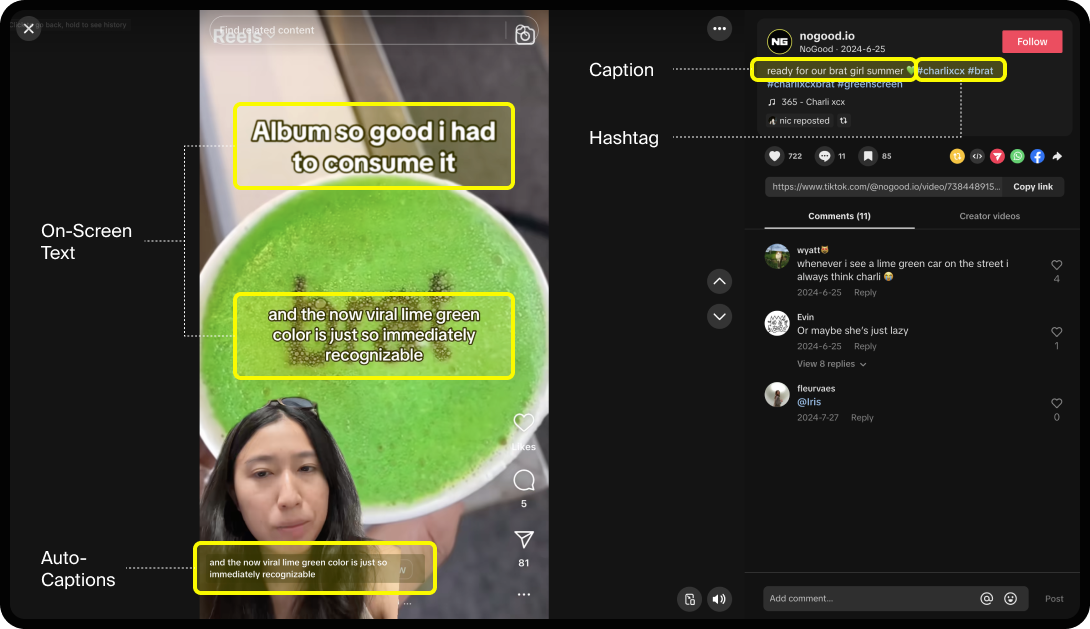
Effective TikTok SEO begins with understanding user intent. Are users seeking inspiration, answers, recommendations, or entertainment? The most discoverable content is that which directly aligns with what users are actively searching for. The more clearly your content addresses that need, the more likely it is to be surfaced in search.
Unlike many traditional platforms, TikTok’s ranking signals don’t factor in follower count. Instead, content performance is assessed by real-time user interactions: views, watch time, likes, shares, saves, and comments. This means that content that resonates rises. This social validation mechanism ensures that search results are powered by relevance and engagement, not legacy reach.
As TikTok continues to evolve its search infrastructure in response to user behavior, the practice of TikTok SEO is becoming more sophisticated. Brands and creators who approach it with intention (grounded in audience insight, content quality, and platform fluency) will have a distinct advantage in shaping what gets found, and by whom.
Google vs. TikTok as a Search Engine
Although Google still leads in terms of what platforms consumers find the most helpful when searching for information, TikTok is rapidly climbing in the rankings. Google has confirmed that TikTok is eating into their search business, particularly amongst younger audiences who value authenticity and community-validated content. In fact, the SVP of Google himself, Prabhakar Raghavan, has said that “new internet users don’t have the expectations and the mindset that [Google] has become accustomed to.”
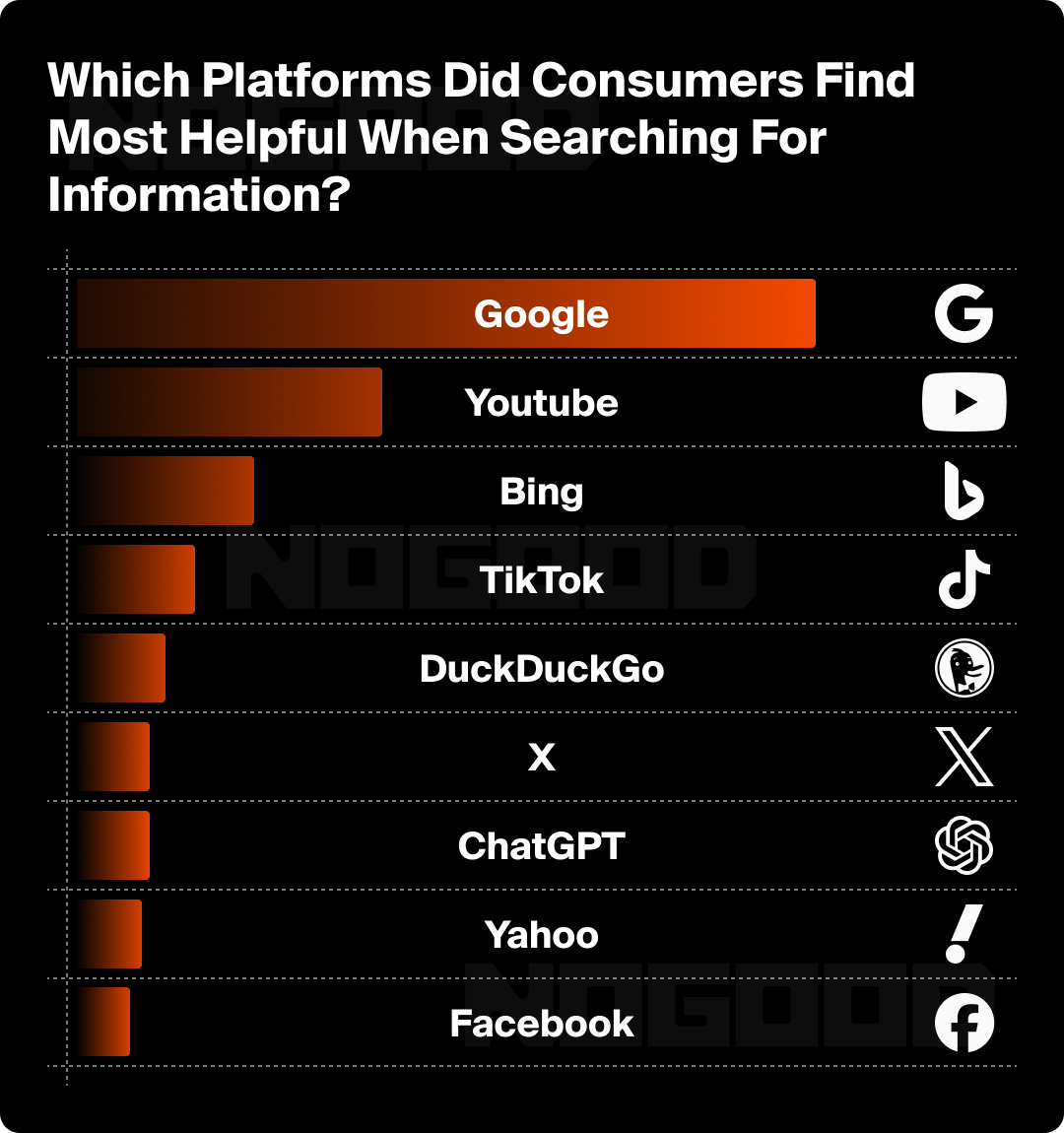
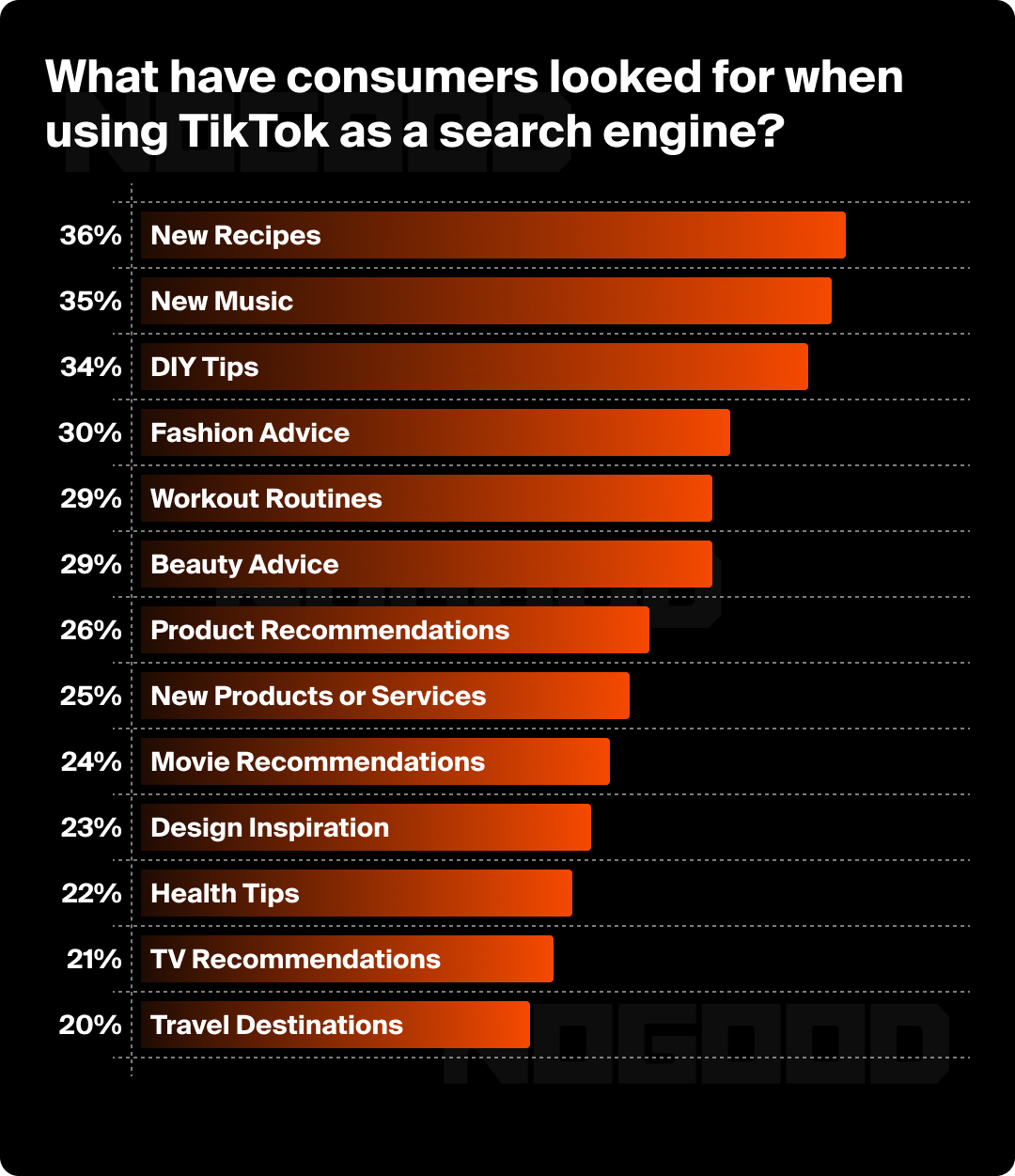
Google’s dominant position in search continues to face mounting pressure in 2025, driven by the rise of AI search engines, shifting user behavior, and the growing relevance of social platforms like TikTok as discovery tools. Following the March 2024 Core update (its largest to date, which aimed to cut low-quality, unoriginal content by 45%), Google doubled down on improving the search experience with the rollout of AI Overviews. These generative summaries now appear across many queries, reshaping how users consume information by prioritizing concise, AI-generated answers over traditional web links.
In parallel, Google has begun surfacing TikTok videos directly in search results for certain queries, particularly those related to lifestyle, how-tos, and trending cultural topics. This signals a broader acknowledgment of the role short-form, user-generated video plays in modern information discovery, and a significant shift in what “relevant” content looks like in today’s search landscape.
This makes TikTok SEO more relevant than ever. Optimizing your TikTok content doesn’t just improve discoverability within the app; it now has the potential to extend your reach onto the Google SERP itself. For creators and brands, this convergence of platforms offers a powerful opportunity to gain visibility across multiple search surfaces with a single piece of content.
Why Is TikTok SEO Important?
The mechanics of search are changing. Where discovery once began with a typed query on Google, it’s now initiated through short-form video, creator reviews, and algorithmically surfaced content on TikTok. Understanding and applying SEO within this context is critical for staying visible in the places where consumer decisions now begin.
1. Gen Z Is Reshaping the Discovery Funnel
TikTok is now the starting point for search for a large segment of Gen Z. Whether they’re looking for a new restaurant, researching a product, or solving a problem, they’re searching within TikTok first; not Google. Recent data shows a clear shift in search preferences among 18–24-year-olds:
- 67% of Gen Z users now turn to Instagram for search
- Instagram is followed closely by TikTok at 62%
- Both platforms are ahead of Google, which ranks third at 61%
While users often rely on multiple platforms for discovery, the fact that TikTok now outpaces Google for search within this demographic signals a foundational change in how information is being sought and trusted. Importantly, Gen Z and Millennials are not isolated user segments. They are early adopters who often set behavioral standards that cascade across demographics.
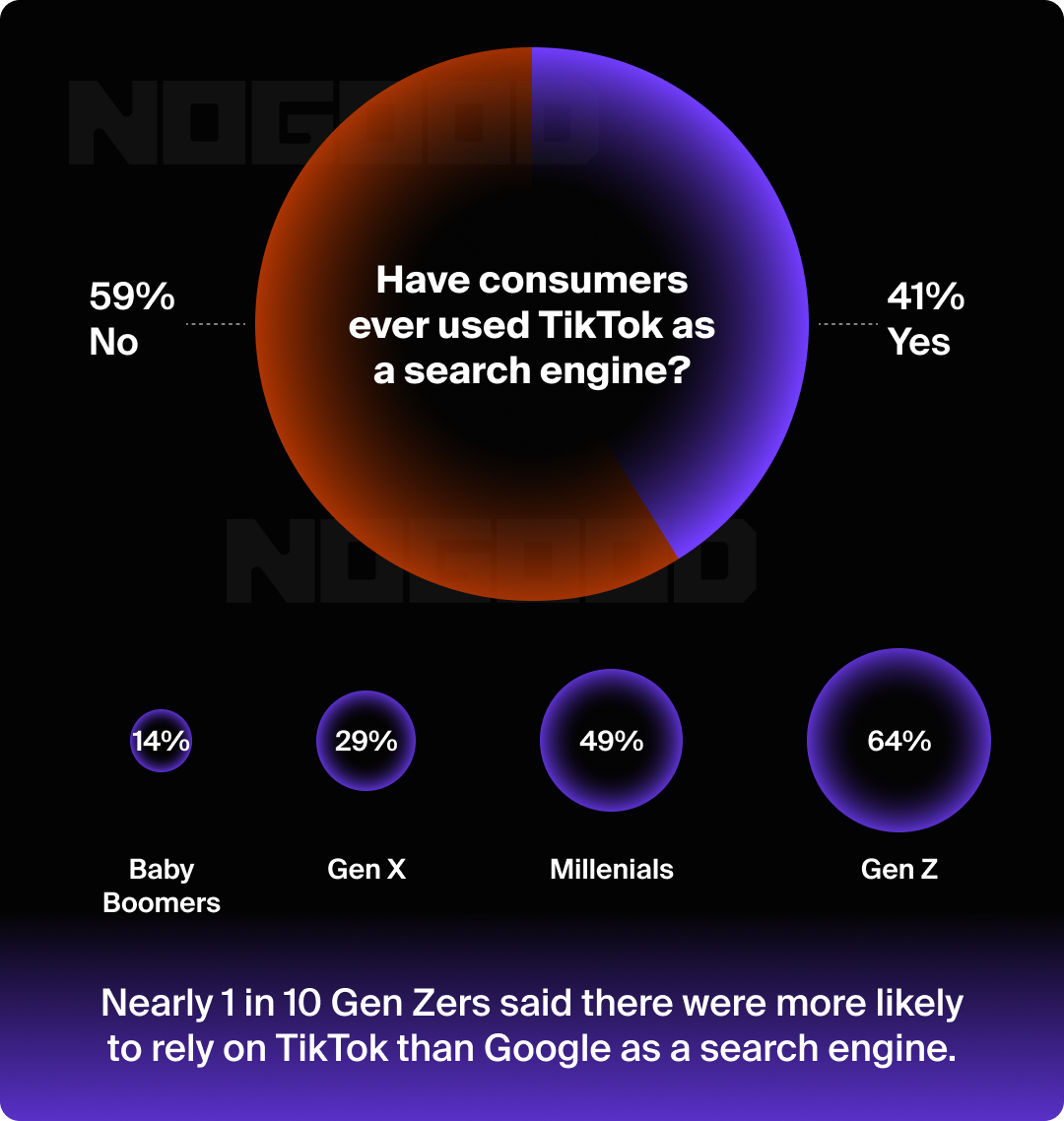
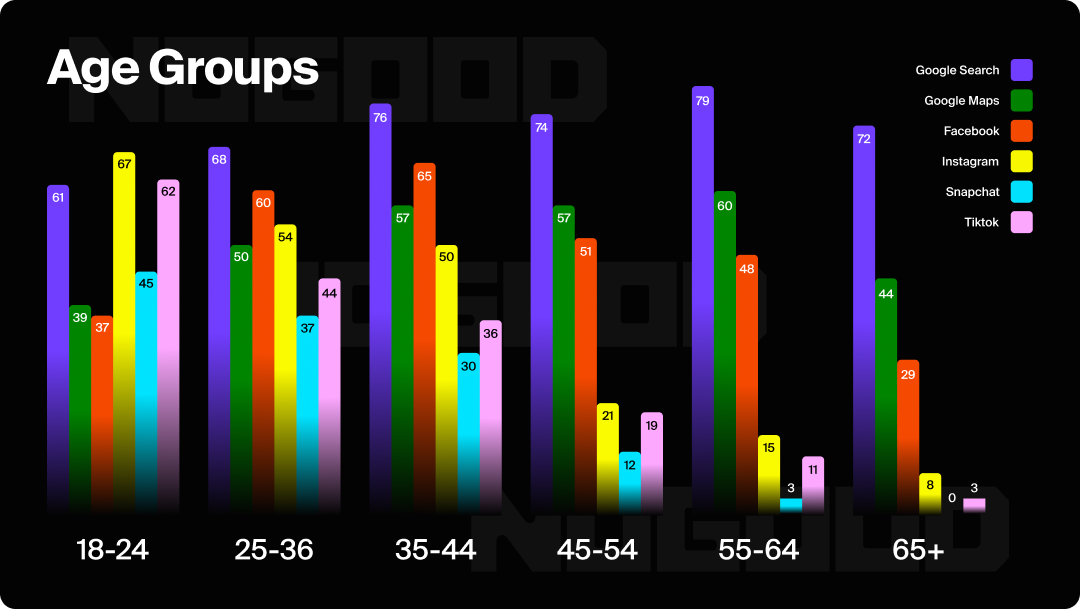
2. Traditional Search Channels Are Losing Consumer Trust
We’re witnessing an erosion of trust in traditional search channels and results. Users are increasingly skeptical of content that is optimized for SEO, appearing to prioritize rankings and click-through rates over actual value.
As a result, many are bypassing Google altogether or modifying their behavior within it; appending terms like “Reddit” to queries or turning to platforms like TikTok, niche forums, and AI answer engines to surface more authentic, peer-driven insights.
This shift stems from a broader consumer mindset: one that demands transparency, community validation, and human context. Recent studies reflect a deepening distrust between consumers and brands, emphasizing that credibility must be earned through ongoing, authentic engagement. In this environment, user-generated reviews, trusted creator voices, and peer-to-peer recommendations carry significantly more weight than polished branded content or keyword-stuffed landing pages.
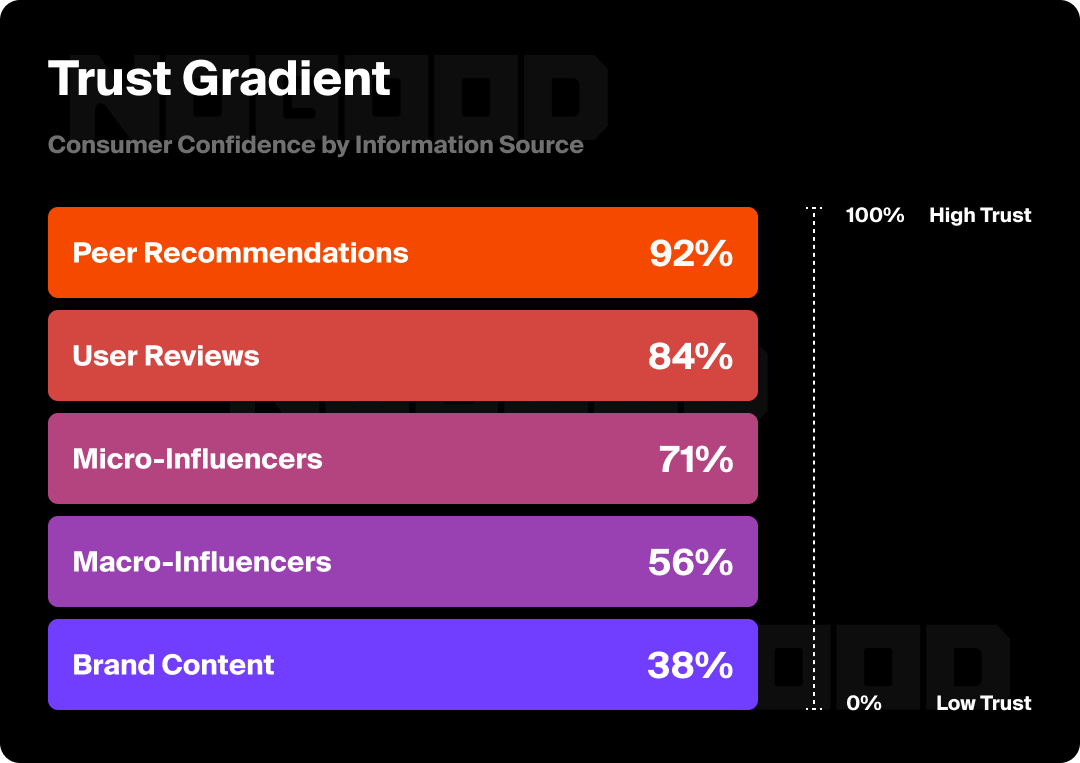
TikTok’s model is uniquely suited to this new search paradigm. Because TikTok is fundamentally a social platform, it holds a unique advantage in which its algorithm surfaces content that performs well with real users, not just content that’s technically well-optimized.
This introduces a new layer to SEO: social validation. Unlike traditional search engines, TikTok doesn’t rely on domain authority or follower count to determine what content ranks. Instead, the algorithm elevates videos based on how real users engage with them: watch time, saves, shares, comments, and other signals of social validation. In short, content earns visibility not by who posts it, but by how well it resonates with the audience.
This is a fundamental departure from traditional SEO. It introduces a more democratic and dynamic layer to discoverability, where relevance is defined by real-time user interaction. For brands and creators, this means that authority isn’t something you build once and defend; it’s something you must continually prove, in the open, through content that earns trust in context.
Even Google itself has acknowledged this shift. In response to growing criticism over the declining quality of its results, it introduced the Helpful Content Update and multiple Core algorithm changes aimed at demoting unoriginal, low-value pages and prioritizing content that demonstrates genuine expertise, experience, and usefulness. These updates underscore what platforms like TikTok already embrace: that helpfulness, not just optimization, is the future of search.
3. TikTok Is Engineering Its Platform Around Search & Commerce
TikTok itself is also observing and actively building for this shift in users’ search behavior. The launch of TikTok Shop in 2023 marked a deliberate move toward becoming a full-funnel eCommerce platform, where search behavior leads directly to transactions. As search queries increasingly center on product reviews, demos, and recommendations, the brands that win are those that surface content aligned with these intent signals.
4. TikTok Content Is Now Indexable by Google
TikTok videos are now appearing on Google SERPs for intent-driven queries, particularly in lifestyle, how-to, and trend-based categories. This has significant implications for SEO strategy. Optimizing TikTok content no longer impacts only in-platform visibility, it now also influences your presence on Google, without necessarily needing a traditional website or blog.
This convergence means your TikTok content can act as a search surface across multiple ecosystems. If you’re investing in SEO without considering TikTok, you’re playing an increasingly outdated game.
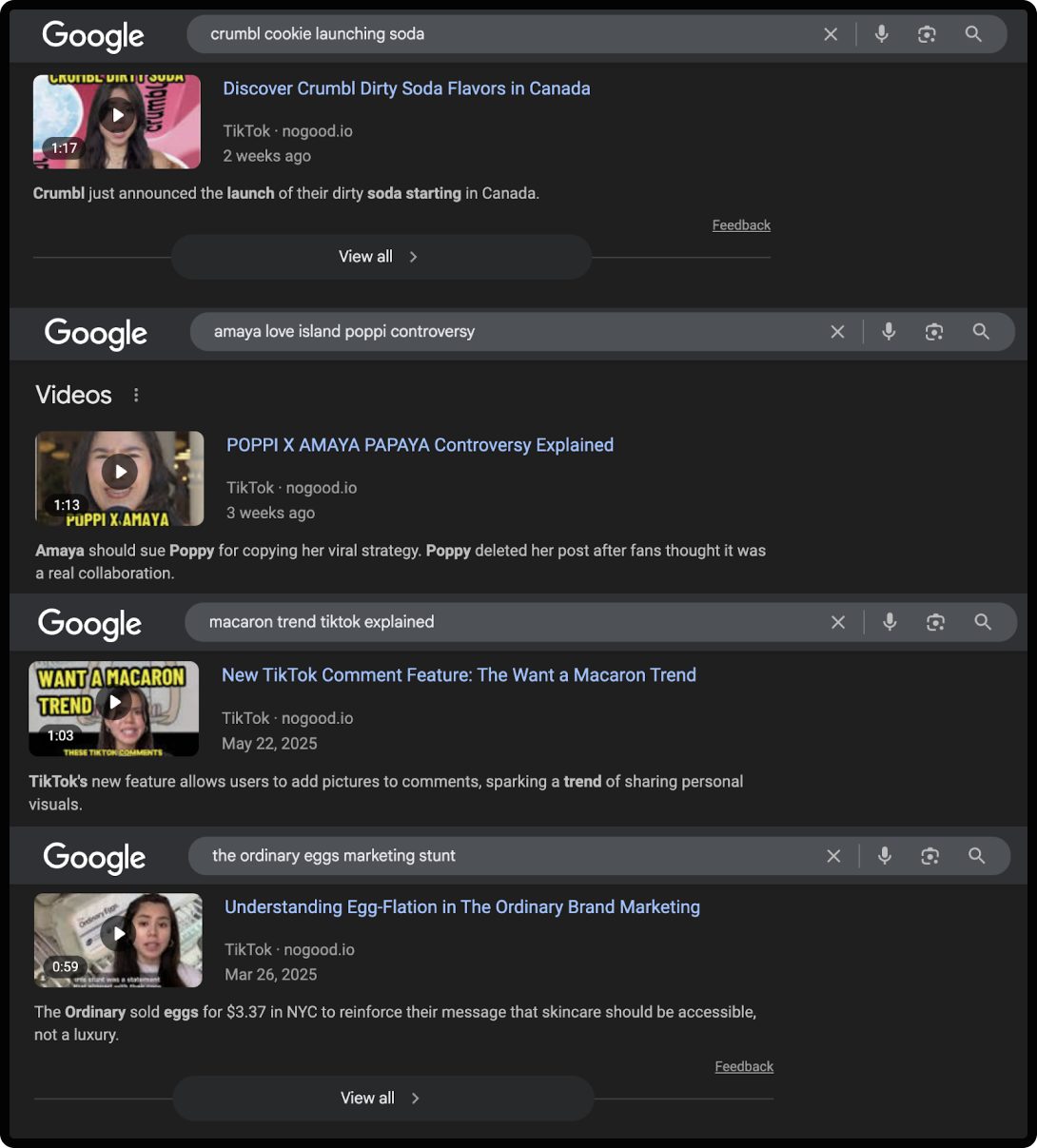
The New TikTok Search Experience
TikTok knows that they’re being used as a search engine, and they’re not shying away from it. The platform has rolled out a series of new search experiences that reflect a clear shift: TikTok wants to be a go-to search engine for users that are looking for visual-first, socially-validated results.
Here are some of the key features that TikTok has rolled out to enhance the social search experience:
1. Smarter Search Infrastructure, Built for Intent
When users enter a query in TikTok’s search bar, they now see auto-complete suggestions that guide them toward high-interest topics. These aren’t random; they’re based on trending search behavior, often reflecting current cultural moments or fast-rising queries.
Similarly, TikTok has introduced linked suggested searches within video comments and below the video frame, encouraging users to follow deeper, related discovery paths; all within the app.
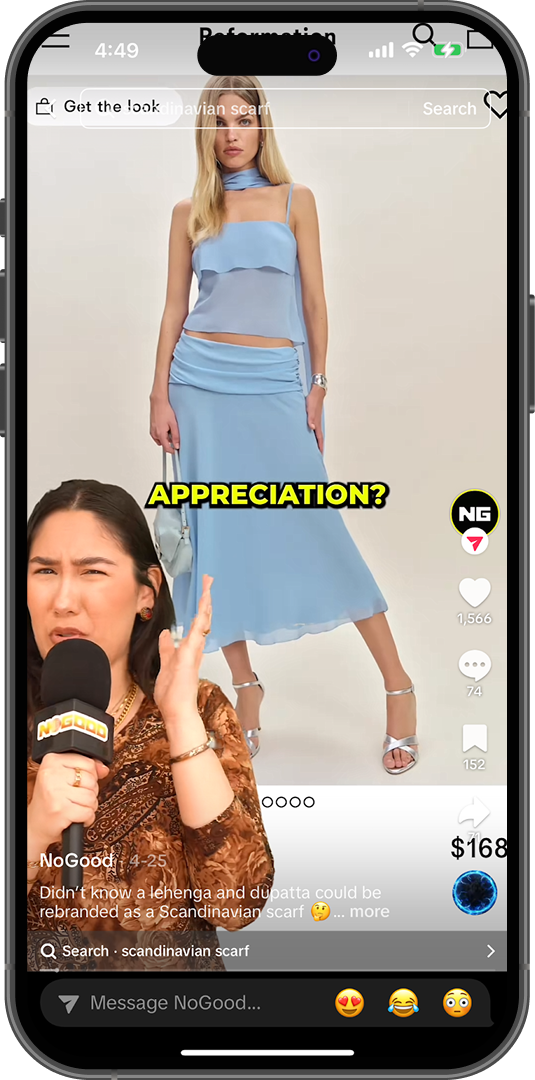
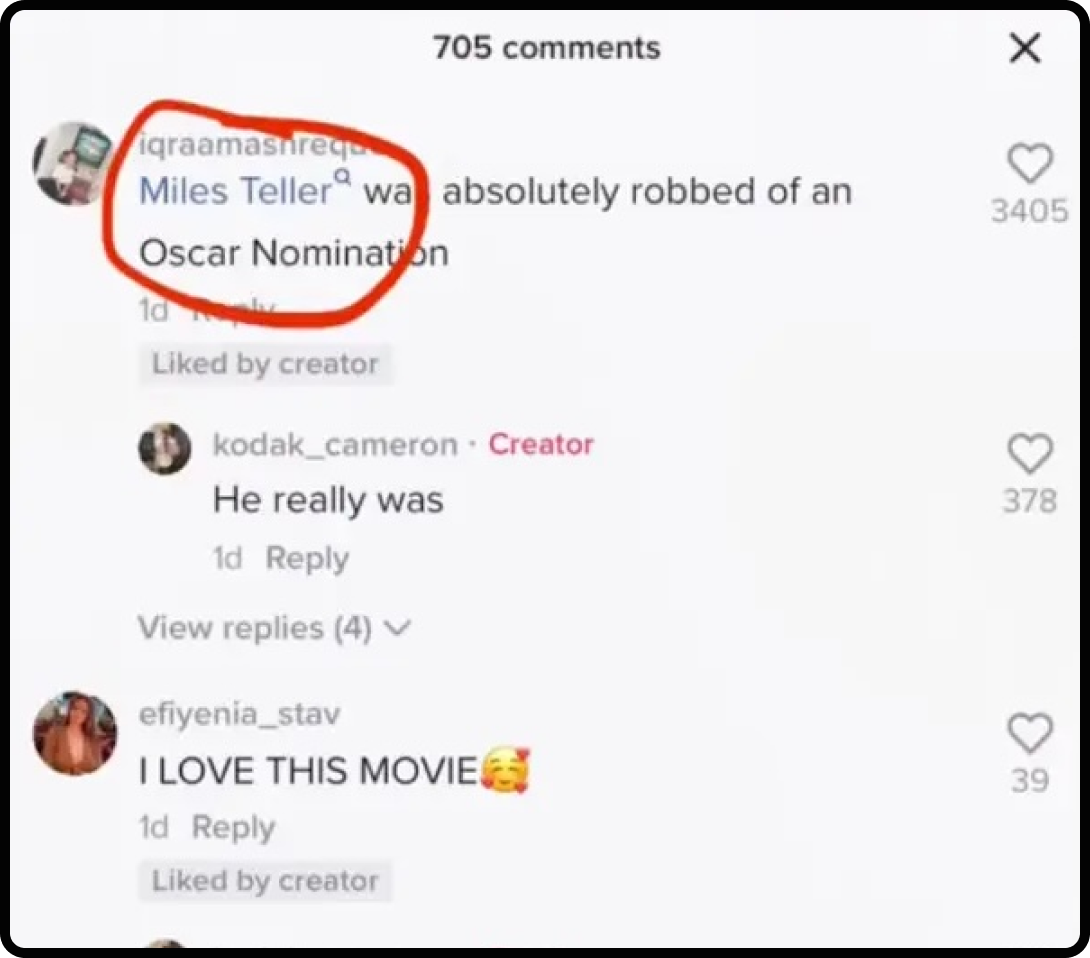
2. Real Search Data for Creators
While TikTok wasn’t initially designed to be a search engine, the platform fully recognizes the growing importance of consumer search behaviors; they’ve since adapted their platform insights to make it easier for brands and creators to optimize their videos for search.
TikTok’s Creator Search Insights is a tool that gives creators insight into topics people are searching for on TikTok, which enables them to source inspiration for their content, tailor their creative strategies to meet audience interests, or create content that people want to see more of.
One of the most interesting features of this tool is that it allows creators to filter for content gap topics; things that are searched for often, but aren’t featured in a large number of videos on TikTok. By identifying these “content gap topics,” TikTok is essentially encouraging creators to contribute to the knowledge bank available on the platform to make it more and more of a helpful, trustworthy search engine.
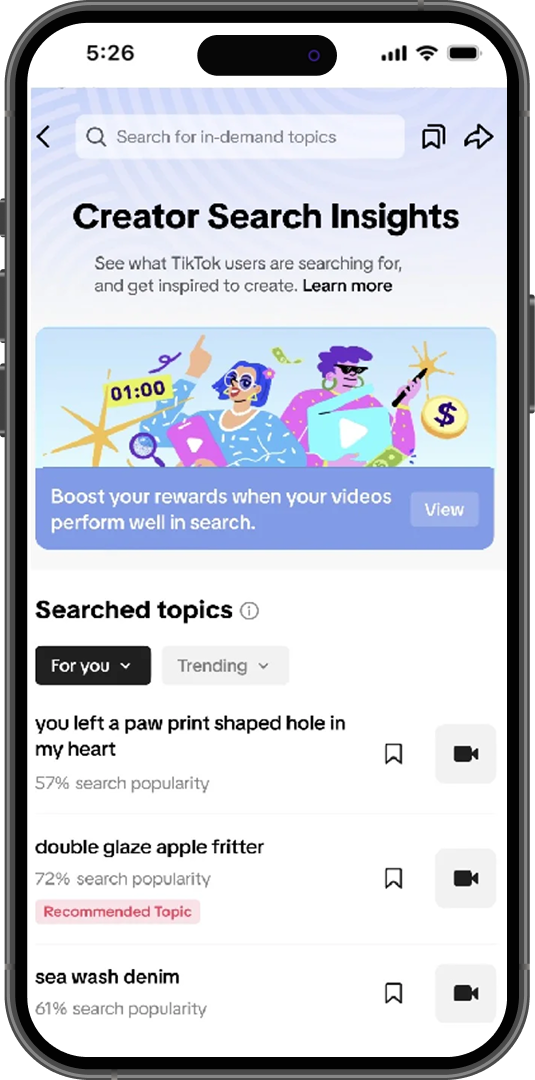
Within TikTok’s in-platform content analytics, you can now also see:
- What percentage of your reach came directly from search
- The exact search terms people used to find your video
- Which keywords or phrases are driving the most traffic
This is a major unlock. It allows creators to reverse-engineer search behavior and tailor content to align with what people are actively looking for. It also surfaces new, high-performing keywords that you may not be targeting; enabling a smarter, more iterative content strategy.
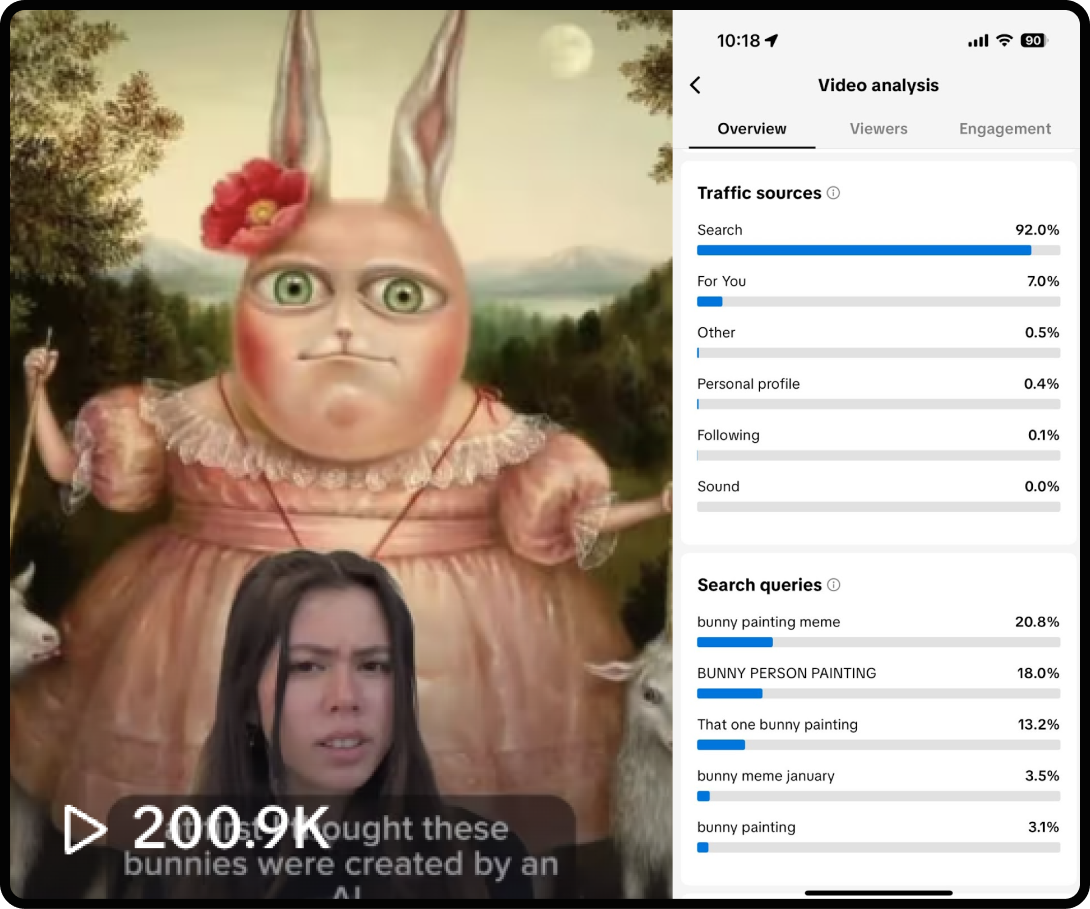
3. AI-Powered Search Summaries
TikTok is also experimenting with AI-generated search highlights; content summaries that appear at the top of some search results pages. These summaries aggregate insights from the most relevant videos and, in product-related searches, even break down FAQs, pros and cons, and user review takeaways.
For creators and brands, this means two things:
- TikTok is actively pushing users toward search-based consumption
- Content that’s informative, clearly structured, and focused on user intent has a higher chance of being featured or surfaced
For example, searching “Oura Ring review” or “Hatch alarm clock pros and cons” on TikTok now pulls up AI-generated summaries that instantly surface the most commonly asked questions, user highlights, and recurring critiques. Instead of sifting through dozens of videos, users get a quick overview; like how Oura Ring is frequently praised for its sleep tracking and design.
Similarly, summaries for the Hatch alarm clock might emphasize the soothing sunrise wake-up feature while noting complaints about its high price. These AI insights package the collective sentiment of TikTok users into a few scannable lines, streamlining the product discovery process within the app itself.
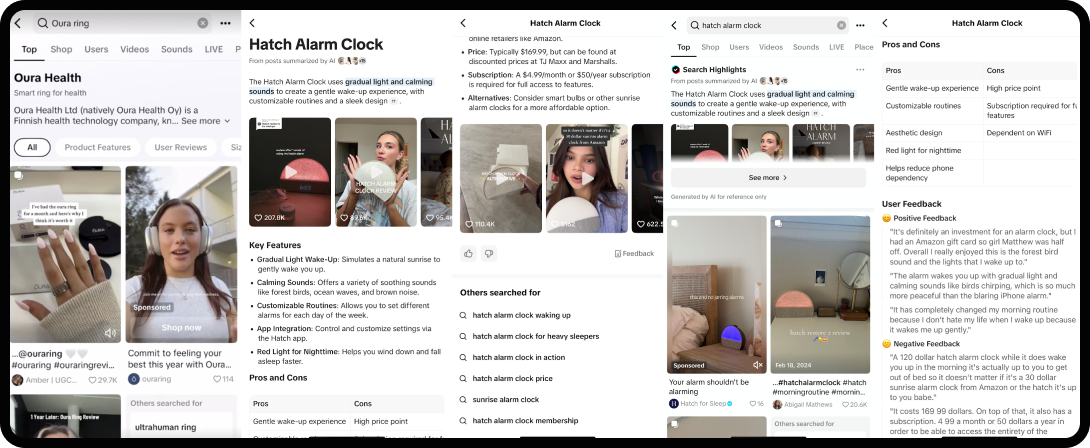
How to Make Your Content Searchable With TikTok SEO
Here’s a simple 5-step formula for optimizing your video content for TikTok SEO:
- Understand your audience and their search intent
- Select the right keywords for your video
- Search your keyword on TikTok and Google, then reverse-engineer content based on top results and user intent
- Strategically incorporate keywords into your content piece
- Use learnings from previous videos to refine your SEO strategy
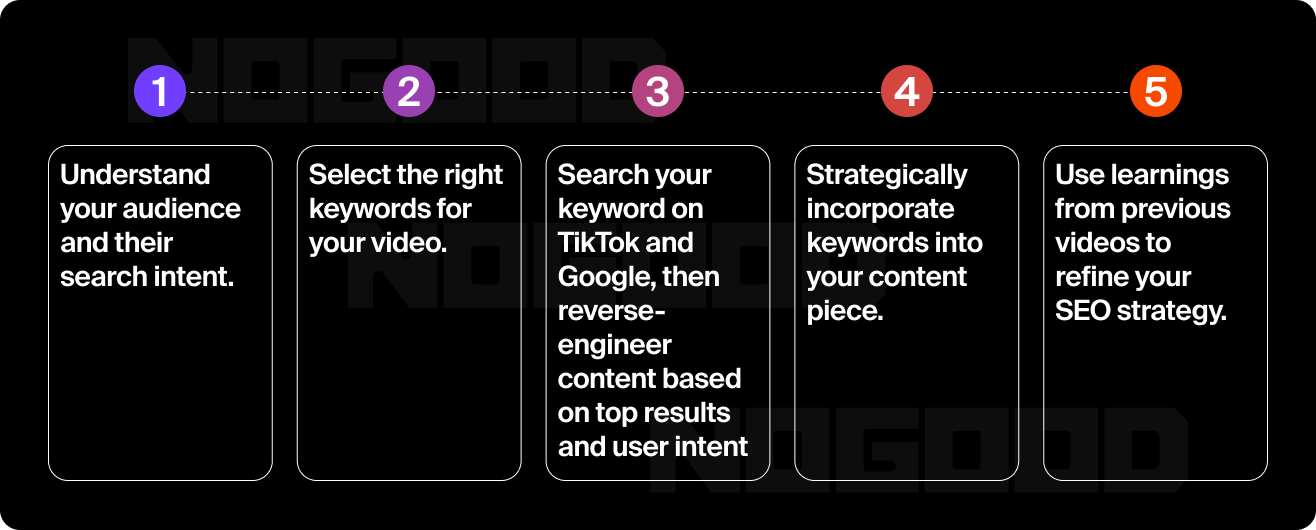
Let’s break it down step by step:
Step 1: Understand Your Audience & Their Search Intent
Before creating your content piece, ask yourself who you’re trying to reach and what that audience might be searching for on TikTok. Are you a hair care brand looking to appeal to consumers searching for the best shampoo products for their hair type? Or are you a new SaaS company targeting small business owners that want tools to help boost their work productivity?
This is where persona mapping and audience research come into play; great content and SEO start with a clear understanding of who your audience is and what information they value.
Understanding your audience and the way your brand fits into their lives is the first step to understanding your ideal audience’s search intent. Search intent reflects the information the user is looking for during their search process, which then informs what kind of content they’d find relevant.
Step 2: Select the Right Keywords for Your Video
Understanding your target audience and their search intent aids the next step of the process: selecting the right keywords to use in your video. There are three key components to consider when selecting keywords for SEO:
- Search Volume: How many people are searching for your keyword
- Relevance: How relevant your content is to the keyword being searched
- Keyword Difficulty: How difficult it is for your content to rank for that keyword (higher keyword difficulty means it’s a more competitive topic to rank for)
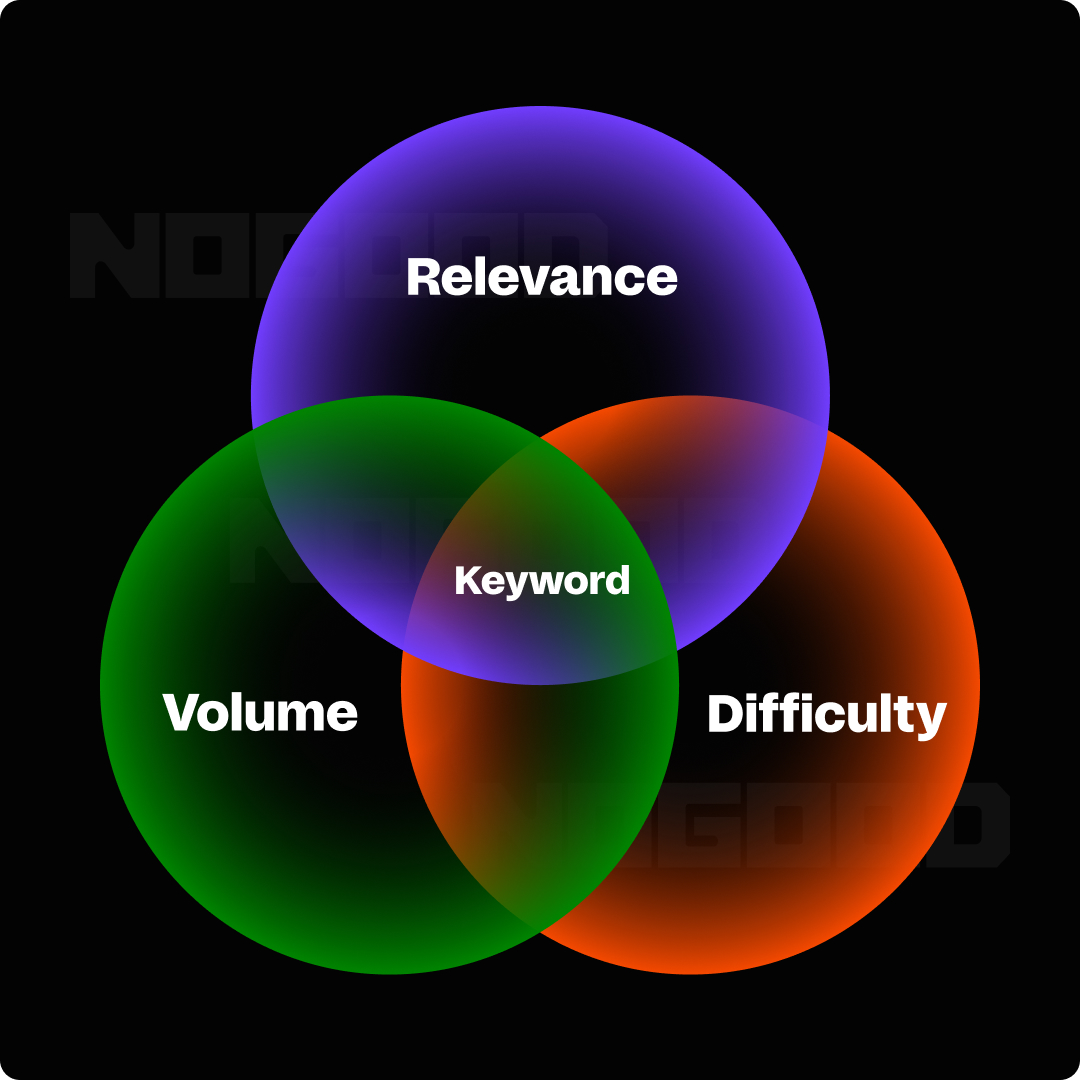
As a general rule, you want to select a keyword with:
- High search volume, making it a keyword that people are actually searching for
- High relevance, making it a keyword that is directly related to your content
- Low keyword difficulty, making it a keyword that is not already oversaturated with relevant content
That being said, there is no one-size-fits-all, foolproof formula for selecting the right keyword. There are instances when these three priorities of volume, relevance and difficulty might contradict one another.
Aiming for a high search volume might give you high keyword difficulty, as other brands and creators are likely to have already created an abundance of content to answer that topic. Likewise, low keyword difficulty might coincide with low relevance; just because a keyword is easy to rank for does not mean that it is necessarily something you want to rank for.
The only right answer to the question of what the best TikTok SEO strategy is, is, “it depends.” Here are some different strategy models for specific circumstances, depending on what stage of growth the brand is in and what the goal of the optimization is:
To reach a niche community as a smaller brand, you’ll want to choose a keyword with:
- Low-medium search volume
- High relevance
- Low keyword difficulty
To create content based on a gap in existing content in terms of relevancy or quality, you’ll want to choose a keyword with:
- High search volume
- High relevance
- Low keyword difficulty
To drive exposure and awareness to a top-of-funnel audience, you’ll want to choose a keyword with:
- High search volume
- Medium relevance
- Low keyword difficulty
The key (pun intended) to choosing the right keyword is balancing all three aspects of volume, relevance, and difficulty, while also keeping in mind what the ultimate goal of your optimization is. Avoid over-prioritizing one aspect, and make sure that your selected keyword always ties back to your audience’s search intent.
It’s also important to target both breadth and depth by incorporating a combination of long-tail and high-volume keywords. Long-tail keywords are longer, more specific, and high-intent keywords that users are more likely to use at a later stage of their search process. These searchers are no longer casually browsing and are entering keywords with a specific action in mind, whether that be to make a purchase, to visit a location, or to answer a question.
Conversely, high-volume keywords are typically shorter, more general keywords that a large population of users is searching for. Ranking for high-volume keywords has the benefit of exposing your content to a large audience; however, search intent will be lower and conversion rates are likely to be not as strong as those of long-tail keywords.
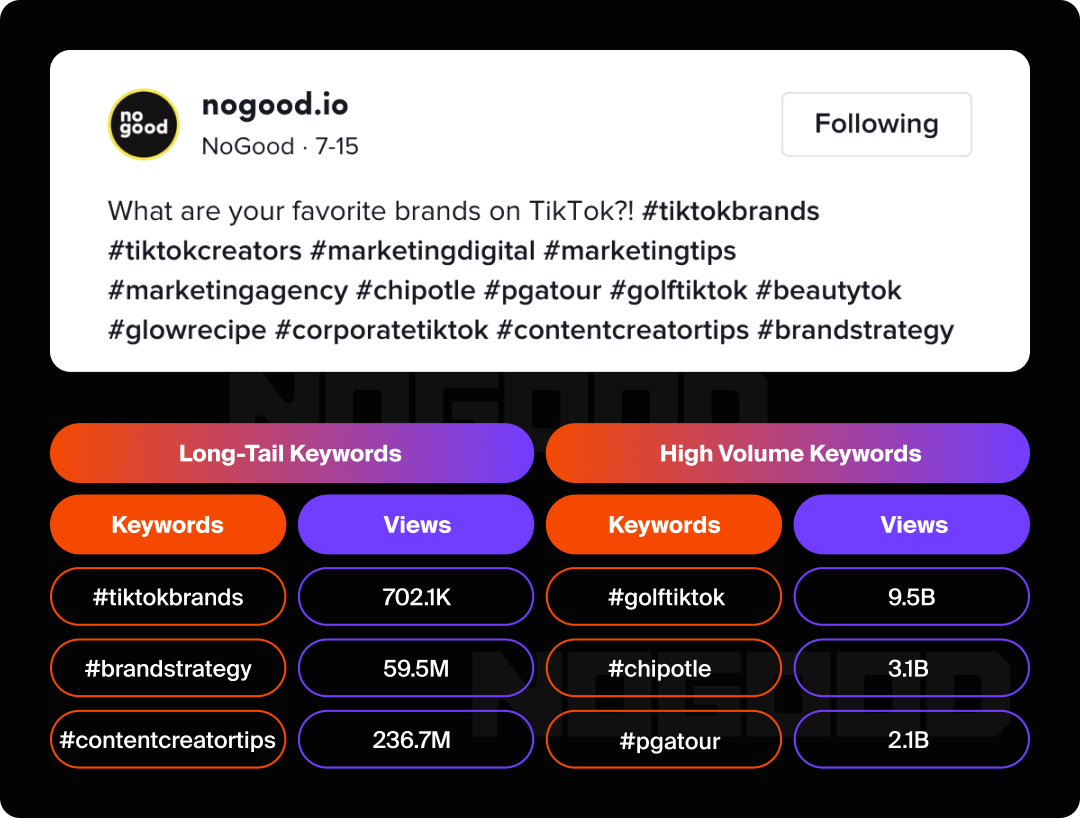
Step 3: Reverse-Engineer Content Based on Top Results & User Intent
Once you’ve identified your priority keywords, it’s time to study what’s already performing. Search your keyword directly on TikTok and Google to analyze the top-ranking videos, carousels, articles, and creators. Ask: what formats are winning? What hooks are they using? Are they educational, entertaining, or opinion-driven?
This is where reverse-engineering comes in; by identifying what content resonates with your audience and aligns with the platform’s algorithm, you can build on proven formulas instead of starting from scratch.
This step is also crucial for interpreting user intent in the wild. Are users searching your keyword because they want a tutorial, a product recommendation, or a hot take? The top results will show you what the algorithm and audience currently favor; use that insight to shape your own angle, format, and content structure.
Step 4: Strategically Incorporate Keywords Into Your Content Piece
There are 5 ways to incorporate keywords into your TikTok videos:
- In-video text
- Speech
- Captions
- Hashtags
- Automated closed captions
And if possible, all five of these options should be used.
Maximizing the different ways your targeted keyword shows up in your video ensures that you’re optimizing your content to rank at the top of the search results page for that keyword. The more times you mention your keyword (within reason), the more likely the platform will register your video as a piece of content that’s relevant for your keyword.
One important thing to note here is that you want to make sure that you’re mentioning your keyword in the first three seconds of your video, and that it shows up on the cover slide.
Doing so not only lets TikTok know what the topic of your video is, but also allows your video to be easily recognized by high-intent searchers looking for information to answer their search queries.
Step 5: Use Learnings to Refine Your TikTok SEO Strategy
The last step is not necessarily tied to any specific video, but is more of a general tip: always use previous videos as a learning tool for refining your TikTok SEO strategy for future videos.
This may come in the form of reusing hashtags on successful videos, creating “part twos” of a certain topic that resonated with your target audience, or even looking at the comments of previous videos to better understand what your audience is looking for.
Every audience base and every brand is different, and while it’s great to follow a tried-and-tested formula for success, the deepest learnings and most specific insights will always come from your own account’s historical data; it’s important to leverage those learnings whenever possible.
How to Find SEO Keywords for TikTok
Finding the right SEO keywords for TikTok starts by understanding what people are already searching for. While TikTok’s Creator Search Insights is the most direct source (surfacing real trending search terms used on-platform) it’s not the only place to look. It’s a great way to stay ahead of rising trends, but more general SEO tools or in-platform features can also help you uncover broader or adjacent keyword opportunities.
1. Use TikTok Search Itself
Start typing your topic into TikTok’s search bar and watch what auto-completes. These suggestions are based on real search behavior, so they offer a goldmine of keyword ideas. Pay attention to phrasing (e.g., “how to,” “best,” “aesthetic,” “ideas for”) and variations that show up across trending content.
2. Tap Into Creator Tools
TikTok Creator Center’s Creator Search Insights shows you which topics are gaining traction and how competitive they are. Use this to spot trending but underserved keywords, or topics people are searching for but aren’t saturated with content yet.
3. Leverage Traditional SEO Tools
Platforms like Ahrefs, Semrush, and Google Keyword Planner can help you identify high-volume search terms relevant to your niche. While these tools were built for Google, many keywords translate well to TikTok, especially informational, how-to, and product-based searches.
4. Browse Comments for Real-Language Queries
Scroll through comments on top-performing videos in your niche. People often ask questions or request related content in the comments, which can clue you into what content or keywords are missing in the space.
5. Use Google’s “People Also Ask” and Related Searches
These SERP features can help you find adjacent topics and questions that people are searching for. If you’re creating TikToks around a product, topic, or trend, this can help you expand your content calendar with related, high-interest topics.
The Future of TikTok SEO
According to a report by Cloudflare, TikTok ended Google’s 15-year reign as the world’s most visited web domain in 2021. If TikTok’s rise to the top is indicative of one thing, it’s that the way users are searching for and consuming information has fundamentally changed.
Consumers are no longer looking for information from the biggest or most established sources. They’re looking for information that’s visually engaging, socially validated, and authentically trustworthy; and with TikTok SEO, brands can certainly take advantage of this shift.
TikTok has already rolled out a slew of search-forward features, and it’s likely to double down on search behavior even further. And it’s not just happening within the app. Google now surfaces TikTok videos in its results and crawls TikTok content for its AI Overviews, meaning that even if you’re not optimizing for discoverability on TikTok, your content could still be surfaced. In short, TikTok SEO isn’t optional anymore.Whether you’re just starting to bring your brand to TikTok or you’re looking to take your brand’s TikTok SEO to the next level, we’re here to make sure your video ranks at the top.







This is was the most insightful thing I read on tiktok SEO. Seems like there are plenty on opportunities on that channel. Thanks for sharing!
I saw your IG post on tiktok taking more of google search traffic from a while back and now I searched for a guide and landed here. Seems like someone is trying to own the space early. Good work.